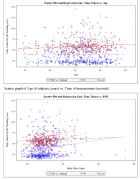Abstract
Research Article
Does global longitudinal strain improve stratification risk in heart failure with preserved ejection fraction?
Assia Haddad*, Mohamed Karim Guerchani, Nadia Ould Bessi, Dalila Djermane, Omar Ait Mokhtar, Hakim Himeur and Salim Benkhedda
Published: 08 September, 2022 | Volume 7 - Issue 3 | Pages: 074-080
Background: Heart Failure with Preserved Ejection Fraction (HFPEF) accounts for more than half of the cases of heart failure.
Long regarded as an abnormality of left ventricular diastolic function, recent studies using longitudinal strain (two-dimensional speckle tracking mode) have suggested that left ventricular longitudinal systolic function is altered in HFPEF.
Despite these interesting pathophysiological perspectives, the data in the literature on the prognostic value of the alteration of longitudinal strain are controversial. Given these conflicting results, it is difficult to confirm the magnitude and prevalence of impaired LV longitudinal systolic function in patients with HFPEF and its prognostic relevance.
Purposes: This work aims to study the prognostic value of Global the left ventricle’s Global Longitudinal Strain (GLS) Algerian cohort of patients with HFPEF.
Patients and methods: We conducted a monocentric prospective observational study from April 2018 to April 2020, with a minimum follow-up of 1 year for each recruited patient. We included patients over the age of 18 referred to the echocardiography laboratory for chronic or acute HFpEF, defined according to the criteria of ESC 2016. 153 consecutive patients underwent clinical examination, biological tests, and echocardiography with measurement of GLS at rest, in addition to routine management by the attending physicians.
Results: 153 patients were collected. The average age of our patients is 73 +/- 11 years ranging from 42 to 91 years old. The female population is predominant with a rate of 67%. Comorbidities are predominant mainly by arterial hypertension (86%) and diabetes (64%), with a history of atrial fibrillation (46%).
63% of patients have impaired GLS (< 16%). Contrary to our hypothesis, GLS was not shown to be a powerful predictor of cardiovascular events in HFPEF patients either in dichotomous analysis (OR = 0.79; p = 0.64) or in continuous analysis (OR = 0.97; p = 0.69).We were able to identify that congestive venous signs, anemia, and pulmonary hypertension, are the main independent prognostic factors in our Algerian population study.
Conclusion: We were unable to demonstrate the prognostic role of mpaired GLS in our population of patients with HFPEF.
Read Full Article HTML DOI: 10.29328/journal.jccm.1001137 Cite this Article Read Full Article PDF
Keywords:
Heart failure; Preserved ejection fraction; Global longitudinal strain; Prognosis
References
- Owan TE, Redfield MM. Epidemiology of diastolic heart failure. Prog Cardiovasc Dis. 2005 Mar-Apr;47(5):320-32. doi: 10.1016/j.pcad.2005.02.010. PMID: 16003647.
- Owan TE, Hodge DO, Herges RM, Jacobsen SJ, Roger VL, Redfield MM. Trends in prevalence and outcome of heart failure with preserved ejection fraction. N Engl J Med. 2006 Jul 20;355(3):251-9. doi: 10.1056/NEJMoa052256. PMID: 16855265.
- Braunwald E. Heart failure. JACC Heart Fail. 2013 Feb;1(1):1-20. doi: 10.1016/j.jchf.2012.10.002. Epub 2013 Feb 4. PMID: 24621794.
- Dunlay SM, Roger VL, Redfield MM. Epidemiology of heart failure with preserved ejection fraction. Nat Rev Cardiol. 2017 Oct;14(10):591-602. doi: 10.1038/nrcardio.2017.65. Epub 2017 May 11. PMID: 28492288.
- Yancy CW, Jessup M, Bozkurt B, Butler J, Casey DE Jr, Drazner MH, Fonarow GC, Geraci SA, Horwich T, Januzzi JL, Johnson MR, Kasper EK, Levy WC, Masoudi FA, McBride PE, McMurray JJ, Mitchell JE, Peterson PN, Riegel B, Sam F, Stevenson LW, Tang WH, Tsai EJ, Wilkoff BL. 2013 ACCF/AHA guideline for the management of heart failure: executive summary: a report of the American College of Cardiology Foundation/American Heart Association Task Force on practice guidelines. Circulation. 2013 Oct 15;128(16):1810-52. doi: 10.1161/CIR.0b013e31829e8807. Epub 2013 Jun 5. PMID: 23741057.
- Vinereanu D, Nicolaides E, Tweddel AC, Fraser AG. "Pure" diastolic dysfunction is associated with long-axis systolic dysfunction. Implications for the diagnosis and classification of heart failure. Eur J Heart Fail. 2005 Aug;7(5):820-8. doi: 10.1016/j.ejheart.2005.02.003. PMID: 15921957.
- Reddy YN, Borlaug BA. Heart Failure With Preserved Ejection Fraction. Curr Probl Cardiol. 2016 Apr;41(4):145-88. doi: 10.1016/j.cpcardiol.2015.12.002. Epub 2015 Dec 9. PMID: 26952248.
- Paulus WJ, Tschöpe C. A novel paradigm for heart failure with preserved ejection fraction: comorbidities drive myocardial dysfunction and remodeling through coronary microvascular endothelial inflammation. J Am Coll Cardiol. 2013 Jul 23;62(4):263-71. doi: 10.1016/j.jacc.2013.02.092. Epub 2013 May 15. PMID: 23684677.
- Borlaug BA, Lam CS, Roger VL, Rodeheffer RJ, Redfield MM. Contractility and ventricular systolic stiffening in hypertensive heart disease insights into the pathogenesis of heart failure with preserved ejection fraction. J Am Coll Cardiol. 2009 Jul 28;54(5):410-8. doi: 10.1016/j.jacc.2009.05.013. PMID: 19628115; PMCID: PMC2753478.
- Morris DA, Ma XX, Belyavskiy E, Aravind Kumar R, Kropf M, Kraft R, Frydas A, Osmanoglou E, Marquez E, Donal E, Edelmann F, Tschöpe C, Pieske B, Pieske-Kraigher E. Left ventricular longitudinal systolic function analysed by 2D speckle-tracking echocardiography in heart failure with preserved ejection fraction: a meta-analysis. Open Heart. 2017 Sep 25;4(2):e000630. doi: 10.1136/openhrt-2017-000630. PMID: 29018535; PMCID: PMC5623331.
- Iacoviello M, Puzzovivo A, Guida P, Forleo C, Monitillo F, Catanzaro R, Lattarulo MS, Antoncecchi V, Favale S. Independent role of left ventricular global longitudinal strain in predicting prognosis of chronic heart failure patients. Echocardiography. 2013 Aug;30(7):803-11. doi: 10.1111/echo.12142. Epub 2013 Mar 14. PMID: 23488596.
- Morris DA, Boldt LH, Eichstädt H, Ozcelik C, Haverkamp W. Myocardial systolic and diastolic performance derived by 2-dimensional speckle tracking echocardiography in heart failure with normal left ventricular ejection fraction. Circ Heart Fail. 2012 Sep 1;5(5):610-20. doi: 10.1161/CIRCHEARTFAILURE.112.966564. Epub 2012 Aug 8. PMID: 22874137.
- Biering-Sørensen T, Santos M, Rivero J, McCullough SD, West E, Opotowsky AR, Waxman AB, Systrom DM, Shah AM. Left ventricular deformation at rest predicts exercise-induced elevation in pulmonary artery wedge pressure in patients with unexplained dyspnoea. Eur J Heart Fail. 2017 Jan;19(1):101-110. doi: 10.1002/ejhf.659. Epub 2016 Nov 22. PMID: 27878925.
- Park JJ, Park JB, Park JH, Cho GY. Global Longitudinal Strain to Predict Mortality in Patients With Acute Heart Failure. J Am Coll Cardiol. 2018 May 8;71(18):1947-1957. doi: 10.1016/j.jacc.2018.02.064. PMID: 29724346.
- Huang W, Chai SC, Lee SGS, MacDonald MR, Leong KTG. Prognostic Factors After Index Hospitalization for Heart Failure With Preserved Ejection Fraction. Am J Cardiol. 2017 Jun 15;119(12):2017-2020. doi: 10.1016/j.amjcard.2017.03.032. Epub 2017 Mar 30. PMID: 28477861.
- Pellicori P, Kallvikbacka-Bennett A, Khaleva O, Carubelli V, Costanzo P, Castiello T, Wong K, Zhang J, Cleland JG, Clark AL. Global longitudinal strain in patients with suspected heart failure and a normal ejection fraction: does it improve diagnosis and risk stratification? Int J Cardiovasc Imaging. 2014 Jan;30(1):69-79. doi: 10.1007/s10554-013-0310-y. Epub 2013 Oct 23. PMID: 24150723.
- Mohammed SF, Borlaug BA, McNulty S, Lewis GD, Lin G, Zakeri R, Semigran MJ, LeWinter M, Hernandez AF, Braunwald E, Redfield MM. Resting ventricular-vascular function and exercise capacity in heart failure with preserved ejection fraction: a RELAX trial ancillary study. Circ Heart Fail. 2014 Jul;7(4):580-9. doi: 10.1161/CIRCHEARTFAILURE.114.001192. Epub 2014 May 15. PMID: 24833648; PMCID: PMC4119596.
- Burke MA, Katz DH, Beussink L, Selvaraj S, Gupta DK, Fox J, Chakrabarti S, Sauer AJ, Rich JD, Freed BH, Shah SJ. Prognostic importance of pathophysiologic markers in patients with heart failure and preserved ejection fraction. Circ Heart Fail. 2014 Mar 1;7(2):288-99. doi: 10.1161/CIRCHEARTFAILURE.113.000854. Epub 2013 Dec 23. PMID: 24365774; PMCID: PMC5947992.
- Buggey J, Alenezi F, Yoon HJ, Phelan M, DeVore AD, Khouri MG, Schulte PJ, Velazquez EJ. Left ventricular global longitudinal strain in patients with heart failure with preserved ejection fraction: outcomes following an acute heart failure hospitalization. ESC Heart Fail. 2017 Nov;4(4):432-439. doi: 10.1002/ehf2.12159. Epub 2017 Apr 20. PMID: 29154416; PMCID: PMC5695196.
- Haykowsky MJ, Kitzman DW. Exercise physiology in heart failure and preserved ejection fraction. Heart Fail Clin. 2014 Jul;10(3):445-52. doi: 10.1016/j.hfc.2014.04.001. Epub 2014 May 22. PMID: 24975908; PMCID: PMC4134949.
- Wang J, Fang F, Wai-Kwok Yip G, Sanderson JE, Lee PW, Feng W, Xie JM, Luo XX, Lam YY. Changes of ventricular and peripheral performance in patients with heart failure and normal ejection fraction: insights from ergometry stress echocardiography. Eur J Heart Fail. 2014 Aug;16(8):888-97. doi: 10.1002/ejhf.124. PMID: 25100109.
- Wang J, Khoury DS, Yue Y, Torre-Amione G, Nagueh SF. Preserved left ventricular twist and circumferential deformation, but depressed longitudinal and radial deformation in patients with diastolic heart failure. Eur Heart J. 2008 May;29(10):1283-9. doi: 10.1093/eurheartj/ehn141. Epub 2008 Apr 2. PMID: 18385117.
- Gozdzik A, Marwick TH, Przewlocka-Kosmala M, Jankowska EA, Ponikowski P, Kosmala W. Comparison of left ventricular longitudinal systolic function parameters in the prediction of adverse outcome in heart failure with preserved ejection fraction. ESC Heart Fail. 2021 Apr;8(2):1531-1540. doi: 10.1002/ehf2.13247. Epub 2021 Feb 11. PMID: 33570238; PMCID: PMC8006621.
- Shah AM, Claggett B, Sweitzer NK, Shah SJ, Anand IS, Liu L, Pitt B, Pfeffer MA, Solomon SD. Prognostic Importance of Impaired Systolic Function in Heart Failure With Preserved Ejection Fraction and the Impact of Spironolactone. Circulation. 2015 Aug 4;132(5):402-14. doi: 10.1161/CIRCULATIONAHA.115.015884. Epub 2015 Jun 30. PMID: 26130119; PMCID: PMC4526442.
- Park JJ, Mebazaa A, Hwang IC, Park JB, Park JH, Cho GY. Phenotyping Heart Failure According to the Longitudinal Ejection Fraction Change: Myocardial Strain, Predictors, and Outcomes. J Am Heart Assoc. 2020 Jun 16;9(12):e015009. doi: 10.1161/JAHA.119.015009. Epub 2020 Jun 10. PMID: 32519555; PMCID: PMC7429069.
- Ho JE, Zern EK, Wooster L, Bailey CS, Cunningham T, Eisman AS, Hardin KM, Zampierollo GA, Jarolim P, Pappagianopoulos PP, Malhotra R, Nayor M, Lewis GD. Differential Clinical Profiles, Exercise Responses, and Outcomes Associated With Existing HFpEF Definitions. Circulation. 2019 Jul 30;140(5):353-365. doi: 10.1161/CIRCULATIONAHA.118.039136. Epub 2019 May 28. PMID: 31132875; PMCID: PMC6684250.
- Zakeri R, Cowie MR. Heart failure with preserved ejection fraction: controversies, challenges and future directions. Heart. 2018 Mar;104(5):377-384. doi: 10.1136/heartjnl-2016-310790. Epub 2018 Jan 5. PMID: 29305560.
- Ku E, Campese VM. Aldosterone and hypertension in African Americans. Am J Hypertens. 2009 Dec;22(12):1234. doi: 10.1038/ajh.2009.174. PMID: 19924116.
Figures:
Similar Articles
-
Indications and Results of Coronarography in Senegalese Diabetic Patients: About 45 CasesNdao SCT*,Gaye ND,Dioum M,Ngaide AA,Mingou JS,Ndiaye MB, Diao M,Ba SA. Indications and Results of Coronarography in Senegalese Diabetic Patients: About 45 Cases. . 2017 doi: 10.29328/journal.jccm.1001007; 2: 013-019
-
Cardiovascular damage during lupus in black African subjectsYaméogo NV*,Tougouma SJ-B,Zabsonré J,Kologo KJ,Tiemtoré WS,Kagambèga LJ,Bagbila WPAH, Traoré A,Samadoulougou AK,Zabsonré P. Cardiovascular damage during lupus in black African subjects. . 2018 doi: 10.29328/journal.jccm.1001024; 3: 031-034
-
An observational study of the occurrence of anxiety, depression and self-reported quality of life 2 years after myocardial infarctionCatrin Henriksson,Mona-Lisa Wernroth,Christina Christersson*. An observational study of the occurrence of anxiety, depression and self-reported quality of life 2 years after myocardial infarction. . 2018 doi: 10.29328/journal.jccm.1001027; 3: 052-063
-
Endogenous sensitizer of beta-adrenergic receptors (ESBAR) and its analogs (review)Victor Tsirkin*,Alexander Nozdrachev,Elena Sizova,Tatyana Polezhaeva,Svetlana Khlybova,Marina Morozova,Andrew Trukhin,Julia Korotaeva,Grigory Khodyrev. Endogenous sensitizer of beta-adrenergic receptors (ESBAR) and its analogs (review). . 2018 doi: 10.29328/journal.jccm.1001028; 3: 064-078
-
Acute viral myocarditis due to Influenza H3N2 infection resembling an acute coronary syndrome: A case reportCarlos Jesus Rodriguez-Zuñiga*,Leonel Martínez-Ramírez,Carlos Alberto Guizar-Sanchez,Mauricio Quetzal Trejo-Mondragon,Nilda Espinola-Zavaleta. Acute viral myocarditis due to Influenza H3N2 infection resembling an acute coronary syndrome: A case report. . 2019 doi: 10.29328/journal.jccm.1001039; 4: 041-042
-
Cardiomyopathies - The special entity of myocarditis and inflammatory cardiomyopathyFelicitas Escher*,Uwe Kühl,Dirk Lassner,Heinz-Peter Schultheiss. Cardiomyopathies - The special entity of myocarditis and inflammatory cardiomyopathy. . 2019 doi: 10.29328/journal.jccm.1001041; 4: 053-070
-
Preclinical stiff heart is a marker of cardiovascular morbimortality in apparently healthy populationCharles Fauvel,Michael Bubenheim,Olivier Raitière,Charlotte Vallet,Nassima Si Belkacem,Fabrice Bauer*. Preclinical stiff heart is a marker of cardiovascular morbimortality in apparently healthy population. . 2019 doi: 10.29328/journal.jccm.1001045; 4: 083-089
-
Late discover of a traumatic cardiac injury: Case reportBenlafqih C,Bouhdadi H*,Bakkali A,Rhissassi J,Sayah R,Laaroussi M. Late discover of a traumatic cardiac injury: Case report. . 2019 doi: 10.29328/journal.jccm.1001048; 4: 100-102
-
Role of novel cardiac biomarkers for the diagnosis, risk stratification, and prognostication among patients with heart failureJennifer Miao,Joel Estis,Yan Ru Su,John A Todd,Daniel J Lenihan*. Role of novel cardiac biomarkers for the diagnosis, risk stratification, and prognostication among patients with heart failure. . 2019 doi: 10.29328/journal.jccm.1001049; 4: 103-109
-
The effect of anemia on serum hepcidin levels in patients with heart failureBetul Borku Uysal*,Feray Akbas,Esma Altunoglu,Gulhan Ipek Denız,Duygu Uysal,Harun Uysal,Hanife Usta Atmaca,Yasin Yuksel,Hale Aral,Guven Cetın,Cem Ar M,Fusun Erdenen. The effect of anemia on serum hepcidin levels in patients with heart failure. . 2019 doi: 10.29328/journal.jccm.1001059; 4: 159-163
Recently Viewed
-
Role of yoga in Parkinson’s disease-A comprehensive update of the literatureRajib Dutta*. Role of yoga in Parkinson’s disease-A comprehensive update of the literature. J Neurosci Neurol Disord. 2020: doi: 10.29328/journal.jnnd.1001033; 4: 038-044
-
Nasal cytology in patients with previous SARS-CoV-2 infection: occurrence of atypical lymphocytesArturo Armone Caruso*, Anna Miglietta, Giovanni De Rossi, Liliana Nappi, Veronica Viola, Stefano De Rossi, Salvatore Del Prete, Clara Imperatore, Sabato Leo, Daniele Naviglio, Monica Gallo, Daniela Marasco, Lucia Grumetto. Nasal cytology in patients with previous SARS-CoV-2 infection: occurrence of atypical lymphocytes. Adv Treat ENT Disord. 2023: doi: 10.29328/journal.ated.1001014; 7: 001-006
-
Impact of Primary Cesarean Section on Grand Multiparous WomenKabbashi Mohammed Adam Hammad, Awadalla Abdelwahid Suliman*, Hajar Suliman Ibrahim Ahmed, Emad Abdalla Siddig Omer, Siddig Omer M Handady. Impact of Primary Cesarean Section on Grand Multiparous Women. Clin J Obstet Gynecol. 2023: doi: 10.29328/journal.cjog.1001140; 6: 126-131
-
The lateralization pattern has an influence on the severity of ankle sprainsAndrzej Mioduszewski*, Mikołaj Wróbel, Emilia Hammar. The lateralization pattern has an influence on the severity of ankle sprains. J Sports Med Ther. 2023: doi: 10.29328/journal.jsmt.1001066; 8: 016-020
-
Role of RBC Parameters to Differentiate between Iron Deficiency Anemia and Anemia of Chronic DiseasesReena Bhaisare*, Ravindranath M, Gurmeet Singh. Role of RBC Parameters to Differentiate between Iron Deficiency Anemia and Anemia of Chronic Diseases. J Hematol Clin Res. 2023: doi: 10.29328/journal.jhcr.1001024; 7: 021-024
Most Viewed
-
Evaluation of Biostimulants Based on Recovered Protein Hydrolysates from Animal By-products as Plant Growth EnhancersH Pérez-Aguilar*, M Lacruz-Asaro, F Arán-Ais. Evaluation of Biostimulants Based on Recovered Protein Hydrolysates from Animal By-products as Plant Growth Enhancers. J Plant Sci Phytopathol. 2023 doi: 10.29328/journal.jpsp.1001104; 7: 042-047
-
Sinonasal Myxoma Extending into the Orbit in a 4-Year Old: A Case PresentationJulian A Purrinos*, Ramzi Younis. Sinonasal Myxoma Extending into the Orbit in a 4-Year Old: A Case Presentation. Arch Case Rep. 2024 doi: 10.29328/journal.acr.1001099; 8: 075-077
-
Feasibility study of magnetic sensing for detecting single-neuron action potentialsDenis Tonini,Kai Wu,Renata Saha,Jian-Ping Wang*. Feasibility study of magnetic sensing for detecting single-neuron action potentials. Ann Biomed Sci Eng. 2022 doi: 10.29328/journal.abse.1001018; 6: 019-029
-
Pediatric Dysgerminoma: Unveiling a Rare Ovarian TumorFaten Limaiem*, Khalil Saffar, Ahmed Halouani. Pediatric Dysgerminoma: Unveiling a Rare Ovarian Tumor. Arch Case Rep. 2024 doi: 10.29328/journal.acr.1001087; 8: 010-013
-
Physical activity can change the physiological and psychological circumstances during COVID-19 pandemic: A narrative reviewKhashayar Maroufi*. Physical activity can change the physiological and psychological circumstances during COVID-19 pandemic: A narrative review. J Sports Med Ther. 2021 doi: 10.29328/journal.jsmt.1001051; 6: 001-007

HSPI: We're glad you're here. Please click "create a new Query" if you are a new visitor to our website and need further information from us.
If you are already a member of our network and need to keep track of any developments regarding a question you have already submitted, click "take me to my Query."
























































































































































